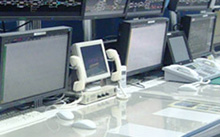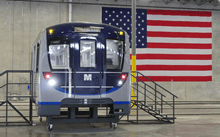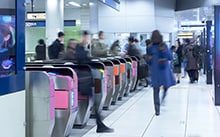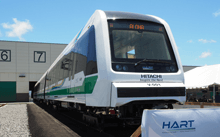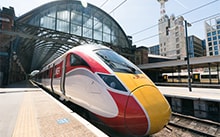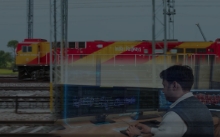Competition for high-speed railway business abroad has been growing among multinational corporations. In 2005 Hitachi became the first Japanese company to manufacture trains for the U.K., the birthplace of railways. In 2012, in recognition of this track record, Hitachi was awarded an official contract for the Intercity Express Programme (IEP), the largest scale rolling stock contract in railway history in the U.K.*1 Hitachi has already completed development on the trains and is making rapid progress toward initial operations.
Competition for high-speed railway business abroad has been growing among multinational corporations. In 2005 Hitachi became the first Japanese company to manufacture trains for the U.K., the birthplace of railways. In 2012, in recognition of this track record, Hitachi was awarded an official contract for the Intercity Express Programme (IEP), the largest scale rolling stock contract in railway history in the U.K.*1 Hitachi has already completed development on the trains and is making rapid progress toward initial operations.
Railway systems have been attracting renewed interest as important infrastructure for society, and new large-scale railway projects have started in many areas of the world. One of the main reasons for this is that rail transportation has less impact on the environment than other forms of transit. People are also re-discovering the unique benefits of railways, which can efficiently move large numbers of people and quantities of goods. In the U.K., the birthplace of railways, construction of the country's first separate railway system for high-speed train service began in 1998. Requirements for the system included superior environmental performance, safety and comfort. The U.K. chose to work with Hitachi.
Hitachi's railway business includes manufacturing rolling stock, providing various systems for the management of railway operations and electrical power as well as information services. In 2005, Hitachi was awarded a contract for manufacturing a fleet of 29 Class 395 trains, including a total of 174 train cars. The Class 395 high-speed trains can run on both existing tracks and on the new 109-km-long, high-speed track, named High Speed 1, which connects London to the Channel Tunnel.
For Hitachi, the project became a groundbreaking opportunity to apply the high-speed train technologies it has developed over the years. However, since this was the first venture of a Japanese train manufacturer in the U.K., there were many challenges from development to delivery. One of the most difficult challenges came from the fact that European standards, which are used in the U.K., are different from those in Japan. Another major issue was how to achieve the standards of high quality that had been developed in Japan on different infrastructure in the U.K.
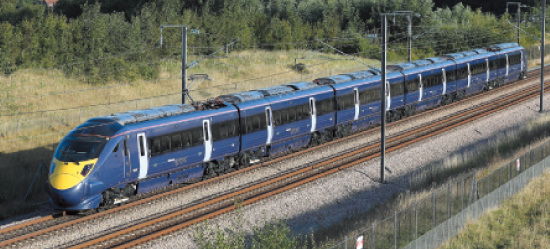
Class 395 trains have been running on High Speed 1, the new high-speed railway that connects London to the Channel Tunnel.
Hitachi conducted verification tests and simulations using supercomputers to develop shock-absorbing structures for trains. The new technology and design were able to meet all the required specifications and safety standards and received approval from the various examining authorities. Hitachi was able to deliver the Class 395 trains ahead of schedule, so the railway was able to commence preview services half a year before Class 395's official debut in December 2009. This was a great surprise for the railway industry in the U.K., where delays in such projects have been commonplace. Since then, the speed and comfort of the Class 395 trains have not only increased convenience for riders, but they have also helped reduce the environmental impact through modal shift.*3 Furthermore, the Class 395 trains are helping to revitalize cities along High Speed 1.
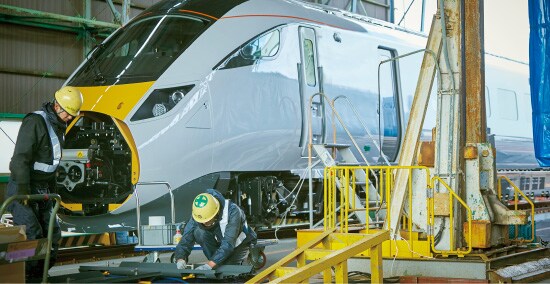
Class 800/801 trains are being manufactured in Japan at Kasado Works in Kudamatsu City in Yamaguchi Prefecture
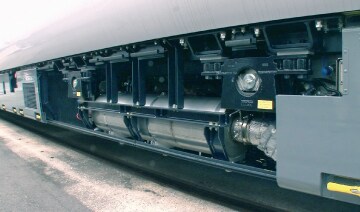
Removable electric generators with diesel engines are used for running on non-electrified sections

Passenger car meets the latest European standards for collision and fire safety (image of prototype)
Recognized for the results of the Class 395 trains, Hitachi was awarded an official contract for the Intercity Express Programme (IEP) in 2012. Including additional orders, the contract covers the delivery of rolling stock (866 train cars) and related maintenance for 27.5 years. IEP is the biggest project in railway history in the U.K. It will replace aging trains that have been running on the Great Western Main Line and the East Coast Main Line, which connect London and other major cities.
Responding to the order, Hitachi began the development of a high-speed train, Class 800/801, for the IEP. Class 800/801 trains needed to be able to run on mixed infrastructure, including multiple lines with non-electrified sections, and work with older platforms and bridges. The Class 800/801 trains also had to meet the U.K. Railway Group Standard (RGS) and the latest European standards, including the Technical Specification for Interoperability (TSI). At the same time, the Class 800/801 trains had to be scalable and flexible to respond to fluctuating numbers of passengers and future plans for electrification. To make operations possible on non-electrified sections, Hitachi installed removable electric generators with diesel engines beneath the floors of train cars. Equipment, including seats and tables, was designed to be accessible by passengers with disabilities. The Class 800/801 trains were able to meet the latest European standards for collision safety and to meet the various other RGS and TSI requirements. The Train Control and Management System on the Class 800/801 trains enables advanced real-time monitoring of train conditions to improve maintenance for the trains.
The Class 800/801 trains were developed based on the "A-train" concept. Aluminium is used to create a lightweight structure. The trains feature an independent interior structure that Hitachi developed in Japan for superior environmental performance, as well as for safety and comfort. In addition, the Class 800/801 trains utilize technology that was developed for the Class 395 trains to make it more suitable for railway systems in the U.K. while also realizing high reliability.
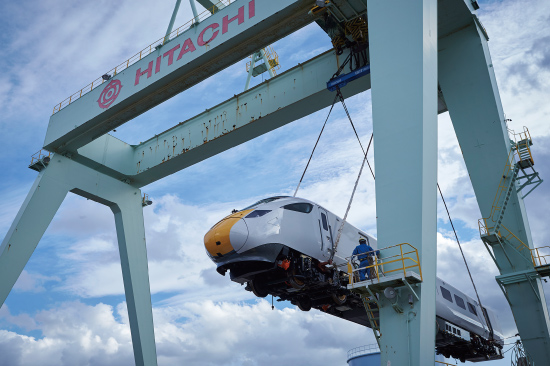
Shipments for Class 800/801 trains from Kasado Works to the U.K. began in January 2015.
In 2015, Hitachi completed the advance production of one Class 800 train and began shipping it from Kasado Works, its home factory in Japan. After the train's arrival in the U.K., the company launched operational tests and began training crews in April 2015. Hitachi plans to manufacture the remaining trains at Kasado Works in Japan and Hitachi's new rolling stock manufacturing plant in Newton Aycliffe, County Durham in the U.K., with a target date in the fall of 2017 for IEP initial operations.
Hitachi remains committed to contributing to high-quality railway service not only in the U.K., but also in other countries around the world.
Video:The Arrival of Class 800 Train for the "IEP" in the UK
Release Date: June 2017
Solutions By: Hitachi, Ltd. Railway Systems Business Unit
